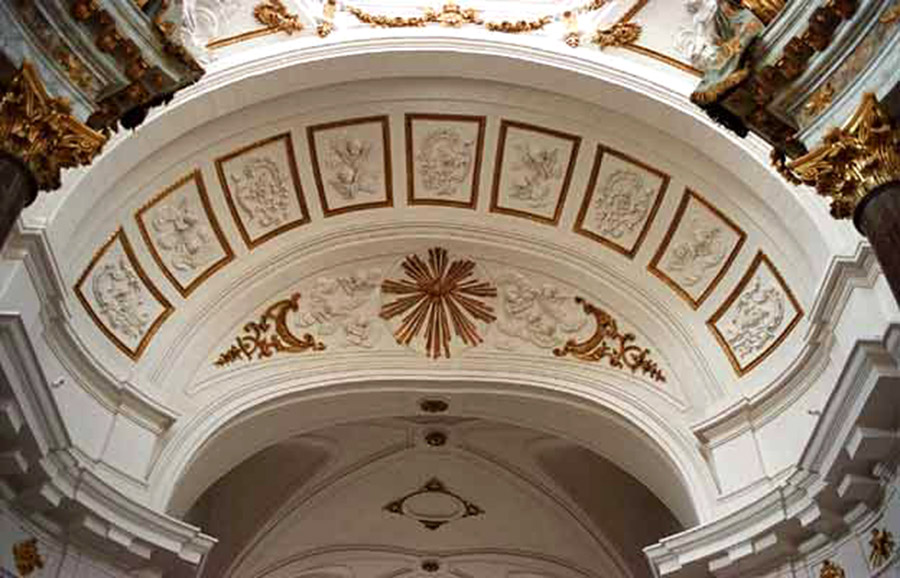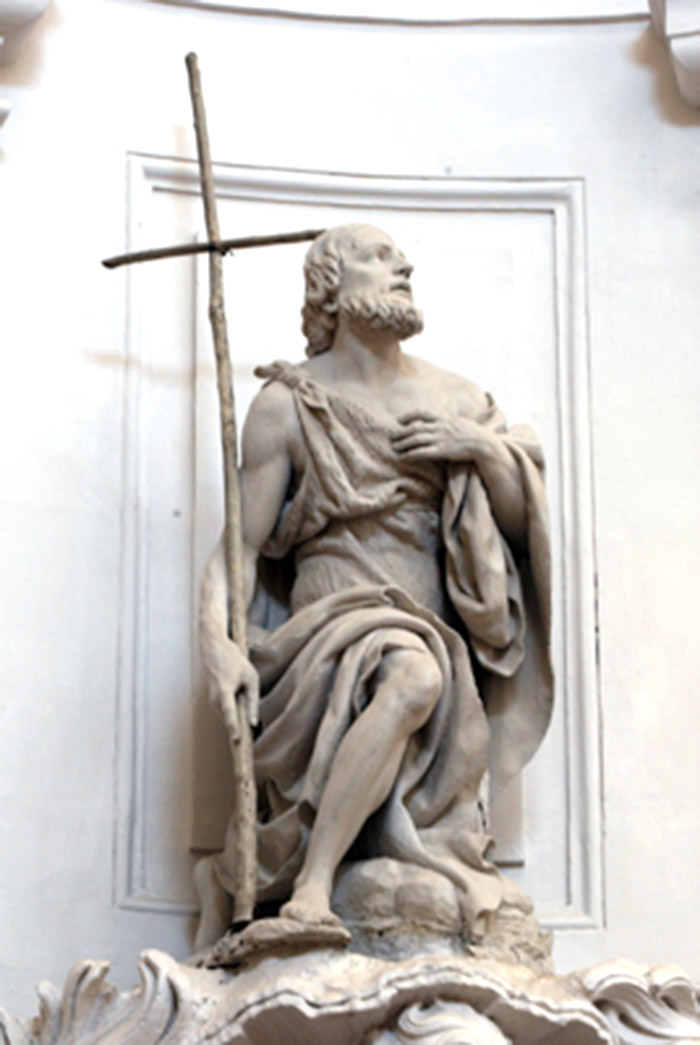As soon as you enter the church, your gaze is immediately drawn to the intersection at the transept which concentrates in its centre most of the Baroque decoration and the artistic jewels of this church. From the eight oval windows of the dome, a white light falls upon the majestic baldachin, glorifying the real presence of Christ in the tabernacle.
Each arm of the transept is enriched with a monumental painting by Trémolières. Two pillar walls, on the choir side, house two statues by Sarrazin representing, respectively, Saint Bruno on the left and Saint John the Baptist on the right. The sculptor Pigalle designed the four Evangelists located in the pendants of the dome.
Everything is made of curves and scrolls in the structure and the decor. Stucco and gold leaf are generously distributed; wood, fabric and marble are extensively used.

Plan by F Delamonce in 1736, showing a section of the dome from the nave, with Munet’s arch in the centre, Archives départementales du Rhône
The Transept – The Dome
Resting upon 17th century walls greatly reinforced by Delamonce, this dome was erected according to the plans of 1736. It is noteworthy for its high drum.
The interior of the dome is elegantly decorated. Pierced by eight large oval windows separated by ribs, it is crowned by a discrete polygonal decoration.
Golden palms occupy the corner of the windows while roses and elements of golden pilasters alternate on the cornice with multiple notches which mark the base of the drum. A garland of roses softens the transition to the four pendants on which rests the entire structure, decorated in stucco, recalling the theme of the Four Evangelists.
The four pendants supporting the cupola of the dome are decorated with stucco on the theme of the four evangelists, work of the sculptor Pigalle (1739). Restored in 2005, they now present eye-catching sculptured portraits of exceptional quality.
St Mathieu |
St Marc |
St Luke |
St John |
Munet’s Arch between transept and choir
Constructed by assistant architect Munet in 1735, the arch is designed to unite the choir and the transept whose elevations are quite different. The arch has the function of bridging the choir and the intersecting transept while the thrusts on either side are all the more different as the nave and the choir do not have the same ground level, nor the same height. Its original character is due to its doubly exceptional shape: sinuous and oblique. It is a very rare architectural device, sometimes called a ‘cow’s horn’. It is buttressed by two tall chapels, not visible, specially built for this purpose.
To better understand the need for the Munet’s arch, please consult the 1736 plan of the church by Delamonce. It appearance is enhanced from the side of the choir by two very strong oblique pillars, advancing before the walls. One notices, in the inferior recesses, two 18th century statues of large angels in stuccoed wood, one carrying the Gospel and the other holding the Crown of Thorns.
Decor on the Choir side : the "Paschal Lamb"

Altar, viewed from the Nave – photo Philippe Dumont
Tabernacle, viewed from the Choir – photo Philippe Dumont
The Altar
The altar was designed by Servandoni in 1737 and modified by Soufflot who gave it its final shape in 1742.
It is double-sided so that services can be celebrated from both the side facing the monks as well as the side facing the faithful.
To magnify the real presence of Christ, the tabernacle was built with the rarest of marbles.
The door of the tabernacle that opens on the choir side represents a pelican, symbol of charity. The door that faces the nave represents the Good Shepherd carrying a sheep in his arms.
The Transept – Paintings by Trémolières
In the two wings of the transept are located two monumental paintings by Pierre-Charles Trémolières, completed in 1737 and placed in their current locations in 1741. They represent the Ascension of Christ and the Assumption of the Virgin into Heaven.
The sumptuous frames were designed by Jacques-Germain Soufflot and executed by François Vanderheyde. From a rocaille cartouche, roses and palms spring up in a continuous upward movement to reach the radiant “glory” of the summit.
Restoration work carried out in the transept in 2005 made it possible to restore the false marble background on which the two paintings are hung.
The Ascension of Christ (east wing of the transept)
This painting represents Christ rising to Heaven, glorified after his Resurrection from the dead.
Below, a small group of apostles and the Virgin watch Christ rise in the sky, surrounded by two angels.
As with the painting of the Virgin’s Assumption facing from the opposite side of the transept, notice the contrast of tones between the warm colors of the earth and the cold colors of the heavens.
The Assumption of the Virgin (west wing of the transept)
This painting represents the Virgin Mary, raised body and soul in the glory of Heaven.
At the bottom, in a large drapery effect, the apostles consider the empty tomb while the Virgin enters the divine world, surrounded by angels. Between the two views, a small angel spreads roses. Notice the contrast between the warm, brown and red tones of the lower section and the cold, white and blue colours of the top of the painting.
Photos Jean-Marie Refflé, DRAC Lyon
Elements of the frames of the Trémolières‘paintings.
The frames were designed by Soufflot and executed by F. Vanderheyde ; on the left, ‘the glory’ at the top of the frames; on the right, the vertical border of the frames.
Photos Philippe Dumont, Jean-Pierre Francisoud
Statues of the transept
These two statues of 1628 in stuccoed wood are the work of Jacques Sarrazin, designed and produced for the decoration of the 17th century church. They were moved, probably in 1878, on the powerful pillar walls of the intersection of the transept whose pilasters in recess provide an appropriate frame.
These two masterpieces are characteristic of 17th century baroque sculpture in two respects : first they are works of movement, and second, of pathos. Saint Bruno in prayer seems to be offering his own person and the entire world to God in a gesture of mystical renunciation. Saint John the Baptist seems to be seized, listening to a dialogue with God.
The soberness of the work is in harmony with the real religious message it is meant to convey. It is characteristic of the Catholic Counter-Reformation and the French religious statuary of the 17th century.
The lamp bases (1746–1747) are the work of Marc II Chabry and are guided by a completely different inspiration. Through these angels, the graces of Heaven have very charming attractions. As the movement grew and as the decorative effect increased in importance, profane inspiration prevailed in the 18th century.
Photos Jean-Marie Refflé, DRAC Lyon













